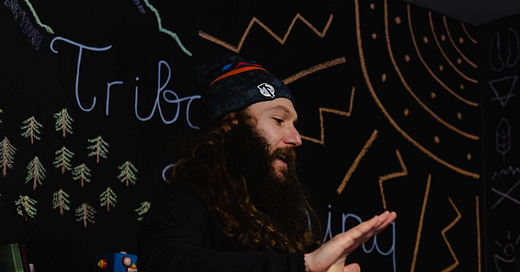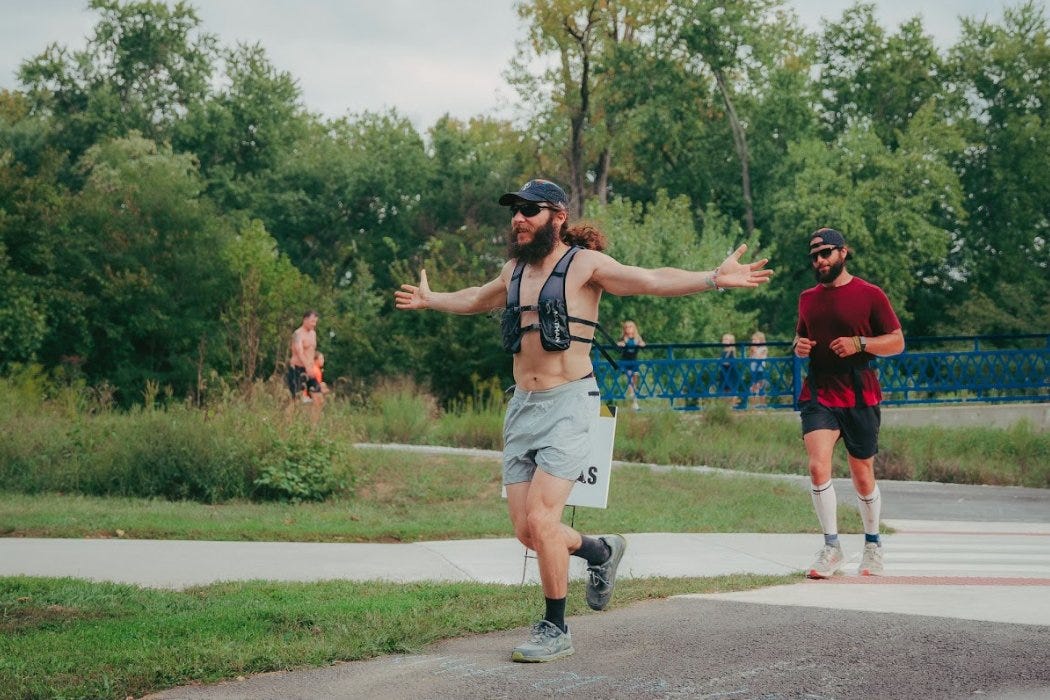I used to live inside my mind
I’m a brainy guy. I was the one who finished all his work at school and then had to figure out what to do while others asked the teacher for help. I remember memorizing state capitals in the back of a dictionary one day just because I could, and didn’t have anything else to do in school (still remember them too!).
I studied for a decade to get my PhD and loved the process. My one supervisor said to me “You’re going to miss the days where all you needed to do was read the books you wanted for 8-10 hours a day.” Man, he was right!
I’m not bragging about my intelligence. Far from it.
What I want to talk about today is how the rational brain gets in the way of living a life of meaning and purpose. As someone with a powerful analytical mind, one of the things I’m helping a lot of people deal with as a coach is over analyzing decisions and filtering life through the rational mind and instead finding the courage to lean into a life defined by a process aimed through the heart.
The ‘everyday’ athlete who overanalyzes
I was talking to an athlete earlier this week who struggles to put his full faith into process.
Like me, he’s got a powerful analytical mind that diverts him back to the comfort of known outcomes. Because he’s able to synthesize disparate information into coherent streams of analysis, it’s easier for him to craft seemingly ‘bulletproof’ justifications that he can convince himself ‘aren’t excuses.’ In this way, the mind becomes a master of mediocrity, of settling, of finding consensus, of coasting, of looking for the shortcut, of wishing for the easy road.
But over time, living a life defined by rational analysis makes us unable to live a life of meaning and purpose. You give away your ability to be an original, to live life on your terms, to go for your dreams, and to be happy no matter what happens. Because you’re really aiming at approval from others, and you give away yourself in order to appear ‘correct’ to them.
Here’s how it works. When you analyze information you want to come to the best conclusion. When making a decision, you want it to seem from the outside that it’s rationally calculated; meaning that if any other person were placed in the exact same situation with the exact same variables and options they would logically make the same decision that you made. It’s not my preference, it’s the truth (you tell yourself).
Sounds correct, but dig deeper and you see how this is a self delusion of epic proportion.
Here’s the reality, you are a SUBJECT. An individual. A one of a kind.
No one else who’s ever lived or will ever live will have your DNA, your experiences, live in the context and environment you do, interact with the people you do, or even view the world from your vantage. You are a 1 in a TRILLION. It makes sense that you will make decisions that are just for you, and that no other person could ever understand. It’s an unjustifiable position to think you can make decisions that other people would also make. It’s not reality. It’s delusional.
So why do people think this way?
It’s fear based stemming from a lack of confidence in displaying your true identity. You don’t want to have to answer why you did something differently. You want people to automatically see you made the correct decision and receive their confirmation in your ‘intelligence.’
It’s hard to explain yourself to someone who doesn’t agree with your choice. It creates anxiety and self doubt. “Did I really make the right decision?”
Someone who is solid in their identity and confident in themselves doesn’t mind being shown to be wrong or they made a mistake. It becomes information to improve and a lesson to learn. But someone who isn’t confident defines themselves as the mistake. You aren’t able to resolve yourself against the critique and internalize the challenge against you as who you are.
And where does it all come from? An overreliance on the rationalization of information to produce an objective answer.
Coaching the ideal of consilience through sport
This is not an easy thought pattern to break for many reasons. The most obvious is that your brain will keep throwing up ‘answers’ to the problem that seem to work but are patterned in that ‘excuse’ making mold.
How can you disassociate yourself from the objective if that’s what matters in the end?
A person in this frame needs more than to be told ‘just believe in the process.’ They won’t be able to. There’s a DEEP need to know that’s so powerful it will sabotage the process. As a coach, how would I approach a person in this situation?
The first thing I would do is appeal to the rational brain. It needs proof. It needs outcomes to confirm the process. It can’t be induced, it must be deduced. I’d talk about the idea of ‘consilience.’
This scientific term is a great way to move from objective to subjective understandings of our personal experiences.
Here’s the idea: when multiple independent streams of analysis converge on the same conclusion, it’s evidence of deep truth. So many different paths can lead to the same truth. There isn’t just one way. Now we’re open to the subjective.
I use this term to help my athletes see that they can find outcomes in a different way. They can focus their attention on the subjective elements of training, while still getting the objective outcomes they desire. The truth will come in and through the training. Now instead of seeing a linear progression that’s rigid, the person now sees the object in a circle with many different lines converging into it. The rational mind appreciates this certainty.
The importance of SCALE in becoming a believer in a process
This is how you start to let the scale of the entire journey start working for you inside that rational mind. You need to see how the micro-decisions scale up to the macro-decisions. How each time I refuse to hit snooze on my watch to get up and exercise leads to me being able to live a life based on my own values. It’s not an easy line to straighten out inside the mind. It requires FAITH.
But how can a mind trained to believe in the objective first find peace in putting faith in the driver’s seat? Don’t worry rational friends, I’ve created a formula that helps explain the entire process: Action + Faith = Becoming
The point of a self development process is to live in a way that forces you to consistently challenge yourself to grow in areas you can improve.
You want to BECOME more than you currently are. But that consistency in highlighting your weaker areas can drain your self belief and desire to act. In order to BECOME you must always be combining faith in yourself and the process with the actions that are necessary to transform.
When you are doing the things you’re supposed to but wondering why you’re still stuck, you need to intensify your faith. Similarly, if you have lots of faith but aren’t yet becoming, it’s time to just do the work. When both are low, you can rely on one or the other to kick start you. Low on faith and action, do the next easy thing and give yourself a bit of grace and a pep talk. This simple formula works so well because it gives the rational mind a foothold in a subjective process. It also works well because it perfectly represents how sports and physical activity work as personal development vehicles.
Just go run in the cold dude
Here’s how this all unfolded in a conversation with that same athlete that struggles to overcome his rational mind pushing him to comfort. He was looking at the coming cold and dark mornings and began switching out his programmed runs for other exercises not on his training plan. This athlete has his eyes set on a fast marathon in 2025. But he was talking about needing to find the fun in training, so he was reverting back to standard weightlifting in the gym.
His rational mind tricked him into the comfortable position. Back to the known and comfy confines of the indoor gym. Back to the ‘fun’ ways to move his body that he can predict and rely on. But what is he trying to accomplish through fitness? It’s not just fun for fun’s sake or even to move to maintain health.
It’s to use training to BREAK THROUGH mental patterns that hold him back. Well well, look at where we found ourselves.
So I checked back to this formula to help him realize the correct course of action from the objective perspective while aiming through the subjective process he’s trying to normalize in his life.
If he wants to become a believer in process, he has to do the actions of the process consistently whether they are ‘fun’ or not. The ‘fun’ comes from seeing yourself making the changes you desire through your effort and hard work. You begin to gain skill and can then become artistic in how you live.
But his rational mind DEMANDS to know it’s working.
So when it comes to just running in the cold dark winter morning, I put it to him this way.
“Earlier in our call you mentioned that decisions around fitness are really easy, not like buying a house for example. So if you have a chance to break a mental pattern with exercise, it’s likely the easiest place to make that change. So if you decide to give into the excuse to ‘go lift inside’ it’s not a big deal in terms of your health but it’s a mortal wound to your process. So win the easy decision with objective action and you’ll begin to up your faith in that process. If you can run 9/10 times outside when you want to stay indoors, you’re building the foundations of the process in the lowest stakes environment. But because it’s tangible and real, you now have the faith in the process in delivering the outcomes you want, the becoming.”
“Well shoot, I guess I have to run in the cold now”
Yes my friend, you do!
Your turn to apply
If you suffer from over rationalization and have the tendency to stay comfortable with a series of ‘bulletproof’ justifications I want you to seriously take this advice and run with it.
In order to become a believer in process over outcomes, each action must feed back into the overall process so that each small victory correctly stacks upon itself. You need to harness the power of scale.
My athlete MM was able to recognize the small decisions of running outdoors vs lifting indoors have huge consequences on the larger process of using exercise to break limiting mental patterns.
Here’s how you can take advantage of the scaling idea to become a believer in your own process.
Step 1: Internalize the formula
Faith + Action = Becoming is a simple equation to keep at the front of your mind. Recognize when one is low and the other needs to kick in harder for support. It’s not enough to just act, or to just believe. It’s the combination of both that makes a process work from the smallest to the largest scales.
Step 2: Define Faith and Action
Everyone has a different need based on their individual journey. Define the terms for yourself, as a subject. What are the actions your need to take? What does faith mean to you? What does the process of becoming look like?
Take time and write down what these means, don’t be afraid to iterate and adapt and you move through the process either.
Step 3: Connect the smallest items to the larger dream
To become a true believer in process you need positive reinforcement that the small steps work to compound up to the big change you desire. If you want to live a healthier lifestyle (big goal) start small with an easy small step, say get up an hour earlier and do a workout before the day starts. Now something like ‘not hitting snooze’ on my alarm clock connects with the bigger goal of living a healthy lifestyle.
Faith + Action team, not just faith or action alone. That’s how you properly thread the scale.
Step 4: Win the consistent easy decisions until mastery
You now have a series of small decisions you can master, like my athelte and the outdoor running example. There’s not a lot of pressure on each decision, but if you don’t consistently make the right one then you won’t find the momentum you desire. If you set your alarm early and don’t hit snooze for a month, you might find yourself waking up before the alarm and naturally falling asleep much earlier. The small wins compound until you have formed a habit!
Step 5: Repeat and Rinse
What’s cool about the process is how transferrable it is. Once you master one new action, reapply to same process to the next level. This is how we keep improving ourselves.
You don’t ‘reinvent the wheel’ each time, you do the same mundane day to day tasks that helped you breakthrough in the first place. It’s a process remember, it never ends. Like a wheel that keeps on turning, keep it in revolution!
Connect with me
This year I’ve refined my coaching process with my individual clients and my tribal training athletes. I’ve helped almost two dozen people break free from limiting patterns in the gym, relationships, business, and self ideal. It’s not an easy process, but one that rewards over time.
One of my guys told me on our final call of the year “I wasn’t always sure of what we were doing, but I kept believing and doing the work and now I see why we the entire path and what we were trying to accomplish.” If we knew the outcome before hand, then we’d never become a believer in the process!
Don’t let the same old limiting rational mind steal your desire to break free and live a life defined by your dreams instead of the mind’s limitations. Use the button below to message me and see if my style of coaching is the exact answer for the endless circles you go around inside your own mind. Let’s break them together and aim you on a process towards your best self. You deserve it my friend!
Have a great new years and I can’t wait to keep growing and learning together in 2025 team!









Loved this post! Consilience is a new word for me and with my love of resilience it’s going to have to become part of my toolkit. Combining the subjective with objective is such a valuable concept both for training and life (which is why I love physical training to optimize resilience in many ways).